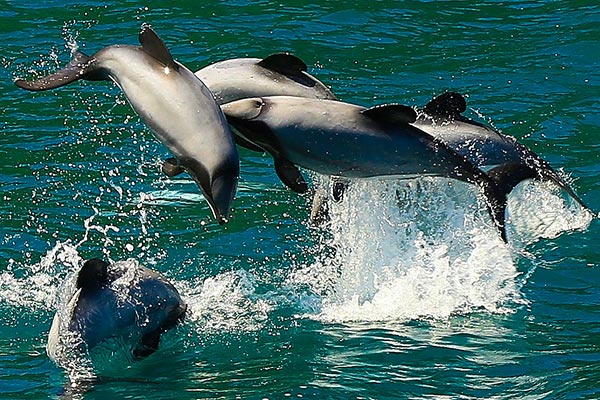Hector’s Dolphin

Facts
Hector’s dolphins are among the world’s smallest marine dolphins. They are found only in the inshore waters of Aotearoa/New Zealand. Two sub-species of Hector’s dolphins exist: the South Island Hector’s dolphin which is found around the South Island of New Zealand, and the Māui dolphin which is found off the west coast of the North Island.
What do they look like?
They are the only dolphins in New Zealand with a rounded black dorsal fin. Their bodies are a distinctive grey, with white and black markings and a short snout. Adult South Island Hector’s dolphins don’t often exceed 1.5 m in length and weigh between 40 and 60 kg. Males are slightly smaller and lighter than females.
Where are they found?
Hector’s dolphins are found around the coast of the South Island but distribution is patchy. Populations are concentrated between Haast and Farewell Spit in the west, around Banks Peninsula in the east, and Te Waewae Bay and Porpoise Bay/Te Whanaga Aihe in the south.
Fascinating facts
- Hector’s dolphins are known to live to a maximum of about 20 years.
- Like other dolphins, Hector’s use echolocation to find their food.
- They send out high frequency ‘clicks’ that bounce off surrounding objects and fish, giving the dolphins a detailed picture of their surroundings.
- This sonar is not used all the time, which may be one of the reasons why the dolphins get caught in nets.
- Females reach sexual maturity between seven to nine years of age. They produce just one calf every two to three years, making population increase a very slow process.
- Hector’s dolphins are one of the smallest marine dolphins in the world.
- Most females only have four or five calves in a lifetime.
- Calving usually occurs between November and mid-February, and calves stay with their mothers for up to two years.
- Traditionally, Māori watched dolphin movements to predict the weather.
Threats
Dolphins and people have shared our coastal waters and bays for centuries. In recent years, there has been a worldwide increase in awareness of marine mammals and a greater desire to protect them. Set net fishing poses a major threat to Hector’s and Māui dolphin. Like all marine mammals they need to come to the surface regularly to breathe. If they become tangled in set nets, they will hold their breath until they suffocate. Because these dolphins occur close inshore, often in bays and harbours, they are at risk of being injured by boats. Newborn dolphins are particularly vulnerable as they swim relatively slowly, close to the surface. Some have been killed by boat propellers when unwary boaties have run them over.

